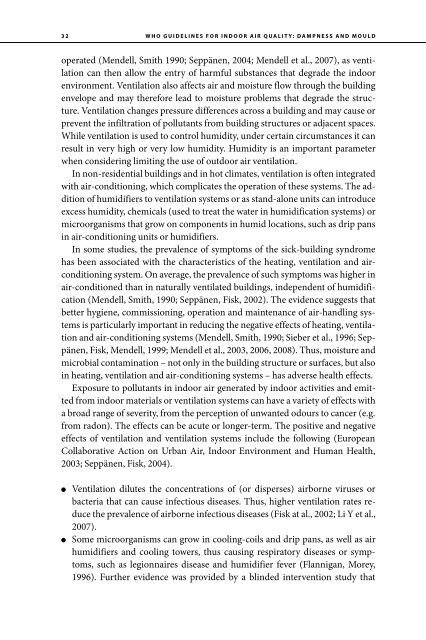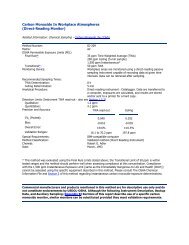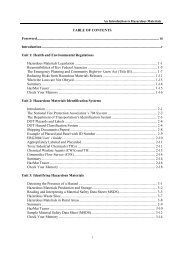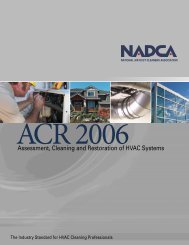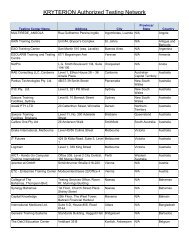Dampness and Mould - WHO guidelines for indoor air quality - PRWeb
Dampness and Mould - WHO guidelines for indoor air quality - PRWeb
Dampness and Mould - WHO guidelines for indoor air quality - PRWeb
You also want an ePaper? Increase the reach of your titles
YUMPU automatically turns print PDFs into web optimized ePapers that Google loves.
32<br />
<strong>WHO</strong> GUIDELINES FOR INDOOR AIR QUALITY: DAMPNESS AND MOULD<br />
operated (Mendell, Smith 1990; Seppänen, 2004; Mendell et al., 2007), as ventilation<br />
can then allow the entry of harmful substances that degrade the <strong>indoor</strong><br />
environment. Ventilation also affects <strong>air</strong> <strong>and</strong> moisture flow through the building<br />
envelope <strong>and</strong> may there<strong>for</strong>e lead to moisture problems that degrade the structure.<br />
Ventilation changes pressure differences across a building <strong>and</strong> may cause or<br />
prevent the infiltration of pollutants from building structures or adjacent spaces.<br />
While ventilation is used to control humidity, under certain circumstances it can<br />
result in very high or very low humidity. Humidity is an important parameter<br />
when considering limiting the use of outdoor <strong>air</strong> ventilation.<br />
In non-residential buildings <strong>and</strong> in hot climates, ventilation is often integrated<br />
with <strong>air</strong>-conditioning, which complicates the operation of these systems. The addition<br />
of humidifiers to ventilation systems or as st<strong>and</strong>-alone units can introduce<br />
excess humidity, chemicals (used to treat the water in humidification systems) or<br />
microorganisms that grow on components in humid locations, such as drip pans<br />
in <strong>air</strong>-conditioning units or humidifiers.<br />
In some studies, the prevalence of symptoms of the sick-building syndrome<br />
has been associated with the characteristics of the heating, ventilation <strong>and</strong> <strong>air</strong>conditioning<br />
system. On average, the prevalence of such symptoms was higher in<br />
<strong>air</strong>-conditioned than in naturally ventilated buildings, independent of humidification<br />
(Mendell, Smith, 1990; Seppänen, Fisk, 2002). The evidence suggests that<br />
better hygiene, commissioning, operation <strong>and</strong> maintenance of <strong>air</strong>-h<strong>and</strong>ling systems<br />
is particularly important in reducing the negative effects of heating, ventilation<br />
<strong>and</strong> <strong>air</strong>-conditioning systems (Mendell, Smith, 1990; Sieber et al., 1996; Seppänen,<br />
Fisk, Mendell, 1999; Mendell et al., 2003, 2006, 2008). Thus, moisture <strong>and</strong><br />
microbial contamination – not only in the building structure or surfaces, but also<br />
in heating, ventilation <strong>and</strong> <strong>air</strong>-conditioning systems – has adverse health effects.<br />
Exposure to pollutants in <strong>indoor</strong> <strong>air</strong> generated by <strong>indoor</strong> activities <strong>and</strong> emitted<br />
from <strong>indoor</strong> materials or ventilation systems can have a variety of effects with<br />
a broad range of severity, from the perception of unwanted odours to cancer (e.g.<br />
from radon). The effects can be acute or longer-term. The positive <strong>and</strong> negative<br />
effects of ventilation <strong>and</strong> ventilation systems include the following (European<br />
Collaborative Action on Urban Air, Indoor Environment <strong>and</strong> Human Health,<br />
2003; Seppänen, Fisk, 2004).<br />
Ventilation dilutes the concentrations of (or disperses) <strong>air</strong>borne viruses or<br />
bacteria that can cause infectious diseases. Thus, higher ventilation rates reduce<br />
the prevalence of <strong>air</strong>borne infectious diseases (Fisk at al., 2002; Li Y et al.,<br />
2007).<br />
Some microorganisms can grow in cooling-coils <strong>and</strong> drip pans, as well as <strong>air</strong><br />
humidifiers <strong>and</strong> cooling towers, thus causing respiratory diseases or symptoms,<br />
such as legionn<strong>air</strong>es disease <strong>and</strong> humidifier fever (Flannigan, Morey,<br />
1996). Further evidence was provided by a blinded intervention study that


